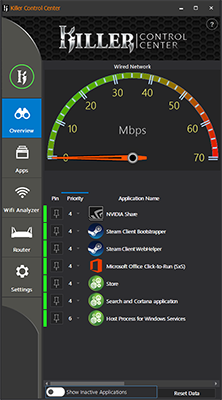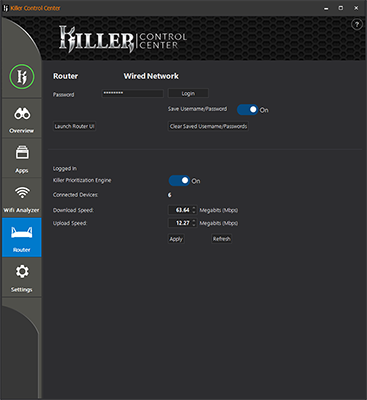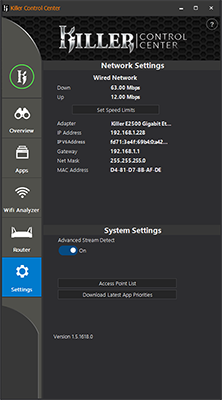Killer Prioritisation Engine
We've established that the Linksys WRT32X performs much like most other modern routers. Performance is solid, be it wired or wireless, and the unit has typical value adds such as low power consumption and the ability to serve as network-attached storage via an onboard USB port.
But all that is frankly missing the point. What sets the WRT32X apart from any router before it is the integrated Killer Prioritisation Engine (KPE). As a gamer-focussed device, the goal here is to ensure that a Killer-enabled client can retain a top-notch experience irrespective of other users hammering bandwidth on the same network.
The caveat, of course, is that owners of the WRT32X need to posses at least one Killer-enabled client, be it laptop or desktop, for the whole package to make sense.
The Alienware 15 R3 laptop supplied for testing features both Killer E2400 Ethernet and Killer Wireless-AC 1435. As before, the hardware components are managed through the lightweight Killer Control Center, whose job is to detect, identify and prioritise latency-sensitive data and other critical network traffic. The software automatically assigns apps a priority rating of 1-6 in order of importance, and though this is done without any user intervention, enthusiasts can choose to manually adjust priorities and limit bandwidth on a per-app basis.
By default, games are typically identified and tagged as priority 1 or 2, audio and video slots in at or around level 3, most general traffic sits at 4 or 5, while large time-insensitive transfers (think torrents or Windows updates) fetch a lowly 6. The software can even identify content running in individual browser tabs, helping ensure, for example, that a YouTube video won't succumb to buffering.
Killer Control Center is for the most part a known quantity, but there is now a new tab that becomes available when the client (in this case an Alienware 15 laptop) recognises a connection to a Killer-enabled router (Linksys WRT32X). This tab offers quick access to the router admin panel, as well as the ability to turn KPE on/off remotely, and we imagine more router-specific controls will be added in future releases.
All sounds familiar, but with the router being factored into the equation, the benefits of KPE are no longer limited to the one client. Games, voice and video on the Killer-enabled device are now prioritised over all other devices on the network, and the benefit works both ways; downloads or torrents on the Killer-enabled device are automatically classed as lower priority to traffic from other devices.
Isn't this all a bit pointless given the advent of ultra-fast broadband? And couldn't users manually prioritise certain traffic using the Quality of Service (QoS) feature available to most affordable routers? Valid questions, and Killer has never been short of detractors, yet for gamers seeking an optimised out-the-box solution that requires no user intervention, the WRT32X does what it says on the tin.
Attempting to simulate a real-world example, the above images show us playing Team Fortress 2 on a Killer-enabled Alienware 15 laptop wired to the WRT32X. At the same time, and on the same network, an iPad is streaming Netflix, a laptop is watching 4K video on YouTube, and a desktop PC is pulling down an 8GB game update. Such a scenario is not uncommon in today's households.
With Killer Prioritisation Engine turned off, in-game ping rises to over 50ms and occasionally shoots up to almost 100ms. Turning KPE on allows the laptop to prioritise the game, while the router puts the laptop at the front of the queue. Ping is reduced to 19ms and doesn't exceed 25ms during gameplay. The difference is even more pronounced when gaming via WiFi, and though casual gamers may not feel the need to maintain low latency at all times, enthusiast gamers will no doubt appreciate the benefit.















